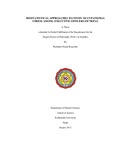Please use this identifier to cite or link to this item:
http://archive.nnl.gov.np:8080/handle/123456789/103| Title: | Biostatistical approaches to study occupational stress among executive officers of Nepal |
| Authors: | Kayastha, Rabindra Prasad |
| Keywords: | Stress Occupational stress |
| Issue Date: | 25-Feb-2018 |
| Abstract: | The purpose of this research is to extend the existing body of knowledge on the occupational stress index among executive officers into the context of governmental and non-governmental organizations of Nepal, as limited research has been conducted with respect to in this field. This is a study of biostatistical analysis used to answer the research questions. A conceptual framework was developed to study the occupational stress index among executive officers in the governmental and nongovernmental sectors in Nepal. The framework so designed illustrates twelve stressors among others that are related to occupational stress. They are: role overload, role ambiguity, role conflict, unreasonable group and political pressures, responsibility assigned to a person, under participation, powerlessness, poor peer relation, intrinsic impoverishment, low status, strenuous working conditions and unprofitability. The hypothesis is framed considering the stressors and their relationship with total occupational stress index including the influence of some major demographic factors such as age, experience, gender, qualification, income and marital status. Occupational stress index questionnaire was used to collect data. The overall response rate from the employees of governmental organizations and nongovernmental organizations were encouraging. The hypothesis was tested using statistical techniques including arithmetic mean, standard deviation, correlation analysis, percentile analysis and analysis of variance- ANOVA. The results indicate that the level of occupational stress experienced by the officers of governmental organizations and nongovernmental organizations were found to be high. The occupational stress on executive officers was reported as the main source of stress. The level of stress on executive officers was generally moderate but showed a tendency towards increasing. Demographic variables such as age, experience, job position and income as well as gender significantly influenced the occupational stress index at 0.05 and 0.01 level of significance. The difference between all age groups for occupational stress came to be significant (F = 9.31, p < 0.01). Stress level is also high in the executives who are in more than 46 years of age (M = 151.07). In years of working experiences, maximum occupational stress has been observed in the executives having work experience between 11 – 15 years of work (M=153.33) as compared to the executives having less number of years of experience (F = 2.80, p < 0.05). The results further indicated that 26.59 percent of EO’s were bearing with high stress and there was significant difference in occupational stress among executive officers working in different organizations in Nepal as the F ratio 8.726, p < 0.05 obtained is to be highly significant. The one-sample test chi-square values eliciting the significance of the difference in the level of stress among executives are also with significant at p < 0.01. The study points out that, the level of mean stress score of occupational stress among executive officers working in different types of organization of Nepal is increasing. The study revealed that there were significant differences obtained in occupational stress in executive officers working in three different kinds of Organizations viz. government officers, other public institutions and private institutions. The study further revealed that executive officers of Nepal were suffering from stress. The statistical approaches used and analysis done brought out many finer aspects and the realistic picture of the stress felt by the EOs. The study also intended to understand stress and its implications besides the effects, it can cause on their health which can be serious. The stressors, the different types of stress and its role, the effects on the individual and the organization, the natural effect, the possible stresses including the stressors have a direct bearing on executive officers have been investigated through these battery of statistical methods. Forecast of the stressors is also attempted by regression analysis. The study also has revealed association of some of the stressors as independent variables and one them being considered as a dependent variable. This study is significant because of the insights obtained for better understanding of occupational stressors embedded in their functions and their workforce with respect to governmental organizations and nongovernmental organizations. Governmental organizations' and nongovernmental organizations' management can use this research findings to formulate adequate and appropriate strategies to address and manage the stress related problems among their employees. |
| Description: | A thesis submitted inn partialfulfillment of the requiremnt for the degree in Doctor of Philosophy in Statistics, Department of Natural Sciences, School of Science, Kathmandu University, 2013. |
| URI: | http://103.69.125.248:8080/xmlui/handle/123456789/103 |
| Appears in Collections: | 300 Social sciences |
Files in This Item:
| File | Description | Size | Format | |
|---|---|---|---|---|
| PhD_Thesis.pdf | 2.22 MB | Adobe PDF |  View/Open |
Items in DSpace are protected by copyright, with all rights reserved, unless otherwise indicated.